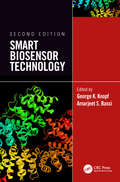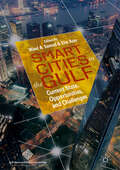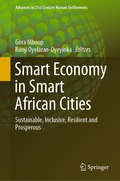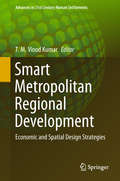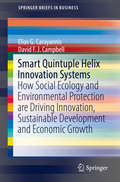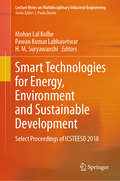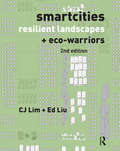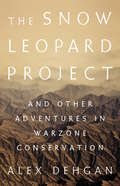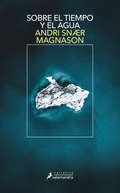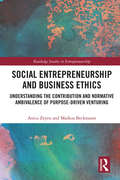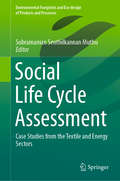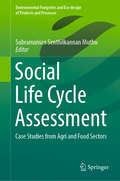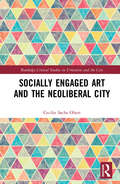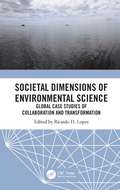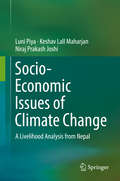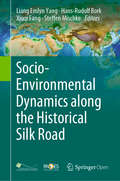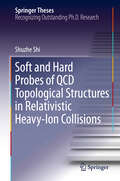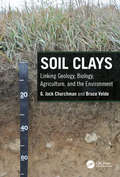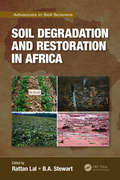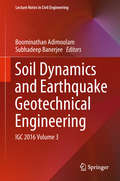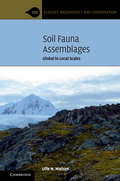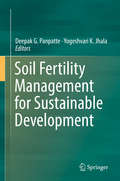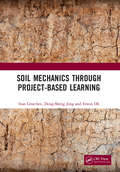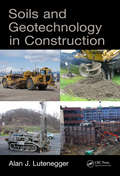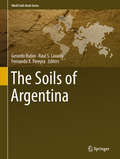- Table View
- List View
Smart Biosensor Technology
by George K. Knopf Amarjeet S. BassiBased on the success of the first edition, this second edition continues to build upon fundamental principles of biosensor design and incorporates recent advances in intelligent materials and novel fabrication techniques for a broad range of real world applications. The book provides a multi-disciplinary focus to capture the ever-expanding field of biosensors. Smart Biosensor Technology, Second Edition includes contributions from leading specialists in a wide variety of fields with a common focus on smart biosensor design. With 21 chapters organized in five parts, this compendium covers the fundamentals of smart biosensor technology, important issues related to material design and selection, principles of biosensor design and fabrication, advances in bioelectronics, and a look at specific applications related to pathogen detection, toxicity monitoring, microfluidics and healthcare. Features Provides a solid background in the underlying principles of biosensor design and breakthrough technologies for creating more intelligent biosensors Focusses on material design and selection including cutting-edge developments in carbon nanotubes, polymer nanowires, and porous silicon Examines machine learning and introduces concepts such as DNA-based molecular computing for smart biosensor function Explores the principles of bioelectronics and nerve cell microelectrode arrays for creating novel transducers and physiological biosensors Devotes several chapters to biosensors developed to detect and monitor a variety of toxins and pathogens Offers expert opinions on the future directions, challenges and opportunities in the field
Smart Cities in the Gulf: Current State, Opportunities, And Challenges
by Wael A. Samad Elie AzarIn this edited volume, academics and practitioners from various disciplines investigate the challenges, opportunities and frameworks in the implementation of Smart Cities in the Gulf.The volume presents insightful analyses and identifies key lessons learned through case studies covering four main themes including smart city frameworks and governance, resources and infrastructure, information and communication technologies, and the social perspective. In doing so, the book provides policy recommendations related to smart governance, as well as overall frameworks that cities can adopt in their process of transition, and knowledge that is integral to bridge the gap between various stakeholders in the Smart City milieu. This edited volume comprises extended versions of papers presented at a workshop held at the University of Cambridge, UK titled “Smart Cities in the GCC: Current State, Opportunities and Challenges.”
Smart Economy in Smart African Cities: Sustainable, Inclusive, Resilient and Prosperous (Advances in 21st Century Human Settlements)
by Gora Mboup Banji Oyelaran-OyeyinkaThis book highlights the use of information and communication technology (ICT) infrastructures in order to develop smart cities and produce smart economies in Africa. It discusses a robust set of concepts, including smart planning, smart infrastructure development, smart economic development, smart environmental sustainability, smart social development, resilience, and smart peace and security in several African cities. By drawing on the accumulated knowledge on various conditions that make cities smart, green, livable and healthy, it helps in the planning, design and management of African urbanization. In turn, it fosters the development of e-commerce, e-education, e-governance, etc. The rapid development of ICT infrastructures facilitates the creation of smart economies in digitally served cities and towns through smart urban planning, smart infrastructures, smart land tenure and smart urban policies. In the long term, this can reduce emissions of CO2, promote the creation of low carbon cities, reduce land degradation and promote biodiversity.
Smart Metropolitan Regional Development: Economic And Spatial Design Strategies (Advances in 21st Century Human Settlements)
by T.M. Vinod KumarThis book discusses the concept and practice of a smart metropolitan region, and how smart cities promote healthy economic and spatial development. It highlights how smart metropolitan regional development can energize, reorganize and transform the legacy economy into a smart economy; how it can help embrace Information and Communications Technology (ICT); and how it can foster a shared economy. In addition, it outlines how the five pillars of the third industrial revolution can be achieved by smart communities. In addition, the book draws on 16 in-depth city case studies from ten countries to explore the state of the art regarding the smart economy in smart cities – and to apply the lessons learned to shape smart metropolitan economic and spatial development.
Smart Quintuple Helix Innovation Systems: How Social Ecology and Environmental Protection are Driving Innovation, Sustainable Development and Economic Growth (SpringerBriefs in Business)
by Elias G. Carayannis David F. CampbellThis volume examines the relationships among social ecology, innovation, sustainable development and economic growth. The Quintuple Helix innovation model focuses on the interactions among five key elements of society: academia, industry, government, culture, and the environment--with particular respect to harnessing knowledge to promote social, political, and economic development. The Quintuple Helix is a powerful theoretical and practical lens for analyzing and understanding such critical and complex ecological and socioeconomic issues as global warming and climate change and their implications for sustainability. The authors provide policy approaches and strategies to help create a balance among the often competing forces of environmental protection, innovation, entrepreneurship, and social and economic growth that will successfully benefit society and protect democratic values.
Smart Technologies for Energy, Environment and Sustainable Development: Select Proceedings of ICSTEESD 2018 (Lecture Notes on Multidisciplinary Industrial Engineering)
by Mohan Lal Kolhe Pawan Kumar Labhasetwar H. M. SuryawanshiThis book comprises select proceedings of the International Conference on Smart Technologies for Energy, Environment, and Sustainable Development (ICSTEESD 2018). The chapters are broadly divided into three focus areas, viz. energy, environment, and sustainable development, and discusses the relevance and applications of smart technologies in these fields. A wide variety of topics such as renewable energy, energy conservation and management, energy policy and planning, environmental management, marine environment, green building, smart cities, smart transportation are covered in this book. Researchers and professionals from varied engineering backgrounds contribute chapters with an aim to provide economically viable solutions to sustainable development challenges. The book will prove useful for academics, professionals, and policy makers interested in sustainable development.
Smartcities, Resilient Landscapes and Eco-Warriors: Resilient Landscapes + Eco-warriors
by CJ Lim Ed LiuFollowing on from the success of the first edition, Smartcities + Eco-Warriors (2010), this book is the latest innovative response on urban resilience from one of the world’s leading urban design and architectural thinkers. An ecological symbiosis between nature, society and the built form, the Smartcity cultivates new spatial practices and creates diverse forms of resilient landscapes including and beyond urban agriculture. The notion of the Smartcity is developed through a series of international case studies, some commissioned by government organisations, others speculative and polemic. This second edition has nine new case studies, and additional ecological sustainability studies covering sensitivity, design criteria, and assessments for ecological construction plans. The book concludes with two new essays on the romance of trees and the empowering nature of resilient landscapes. Smartcities, Resilient Landscapes + Eco-warriors represents a crucial voice in the discourse of climate change and the potential opportunities to improve the ecological function of existing habitats or create new landscapes which are considered beneficial to local ecology and resilience. It is indispensable reading for practitioners and students in the fields of landscape, urban design, architecture and environmental engineering. An inspiration to government agencies and NGOs dealing with sustainability, this work also resonates with anyone concerned about cities, landscapes, food and water security, and energy conservation.
The Snow Leopard Project: And Other Adventures in Warzone Conservation
by Alex DehganThe remarkable story of the heroic effort to save and preserve Afghanistan's wildlife-and a culture that derives immense pride and a sense of national identity from its natural landscape.Postwar Afghanistan is fragile, volatile, and perilous. It is also a place of extraordinary beauty. Evolutionary biologist Alex Dehgan arrived in the country in 2006 to build the Wildlife Conservation Society's Afghanistan Program, and preserve and protect Afghanistan's unique and extraordinary environment, which had been decimated after decades of war.Conservation, it turned out, provided a common bond between Alex's team and the people of Afghanistan. His international team worked unarmed in some of the most dangerous places in the country-places so remote that winding roads would abruptly disappear, and travel was on foot, yak, or mule. In The Snow Leopard Project, Dehgan takes readers along with him on his adventure as his team helps create the country's first national park, completes the some of the first extensive wildlife surveys in thirty years, and works to stop the poaching of the country's iconic endangered animals, including the elusive snow leopard. In doing so, they help restore a part of Afghan identity that is ineffably tied to the land itself.
Sobre el tiempo y el agua
by Andri Snaer MagnasonUn libro para comprender el futuro del planeta si no actuamos de inmediato. Sobre el tiempo y el agua es un ensayo narrativo profundo y convincente sobre la crisis medioambiental global y, a la vez, una íntima y desesperada súplica al mundo. Nació de una conversación con un científico puntero convencido de que son los escritores, y no los científicos, los más capacitados para hablar de uno de los asuntos más apremiantes para la humanidad. Los argumentos que esgrime son, pues, indistintamente mitológicos o científicos, anecdóticos o estrictamente morales y filosóficos. El resultado es un rico entramado de relatos de viaje, historias familiares, momentos poéticos: un libro bellísimo, a la vez que urgente.
Social Entrepreneurship and Business Ethics: Understanding the Contribution and Normative Ambivalence of Purpose-driven Venturing (Routledge Studies in Entrepreneurship)
by Anica Zeyen Markus BeckmannSocial entrepreneurs are change makers that aim to solve society’s unsolved problems. Not surprisingly, social entrepreneurship has thus created high expectations. To better understand the potential as well as the limitations of social entrepreneurship, however, a more nuanced approach is needed in two ways. First, social entrepreneurship is a multi-level phenomenon. It spans macro-level questions as well as meso-level questions and, finally, micro-level questions. If we really want to understand social entrepreneurship, we need to bring together all three levels of analysis and see how they are connected. Second, while social entrepreneurship can certainly produce socially desirable outcomes, we also need a critical perspective to capture potential undesirable effects that social entrepreneurship can cause, often unintendedly, in society, in markets, in organizations, and for individuals. To this end, an ethical perspective can help complement the positive analysis of social entrepreneurship with a discussion of the normative implications of its potential "dark side". Looking at social entrepreneurship from both a multi-level analysis and an ethical perspective, Social Entrepreneurship and Business Ethics takes the reader on a journey through the "bright side" as well as the potential "dark side" of social entrepreneurship for societies, organizations, and individuals. Highlighting both, this book not only seeks to provoke researchers and students to advance their understanding of social entrepreneurship. It also hopes to help practitioners to better realize the positive contributions of social entrepreneurship for society.
Social Life Cycle Assessment: Case Studies from the Textile and Energy Sectors (Environmental Footprints and Eco-design of Products and Processes)
by Subramanian Senthilkannan MuthuThis book highlights the Social Life Cycle Assessment (SLCA) of the energy and textile sectors. It also presents a range of models, indices, impact categories, etc. for SLCA that are currently being developed for industrial applications. Though SLCA was introduced in 2010, it is still relatively new compared to environmental life cycle assessment (ELCA).
Social Life Cycle Assessment: Case Studies from Agri and Food Sectors (Environmental Footprints and Eco-design of Products and Processes)
by Subramanian Senthilkannan MuthuThis book highlights the Social Life Cycle Assessment (SLCA) of the agri-sector for rice, sugarcane, and cassava in Thailand and the food sector. It also presents a range of models, indices, impact categories, etc. for SLCA that are currently being developed for industrial applications. Though SLCA was introduced in 2010, it is still relatively new compared to environmental life cycle assessment (ELCA).
Socially Engaged Art and the Neoliberal City (Routledge Critical Studies in Urbanism and the City)
by Cecilie Sachs OlsenWhat are the social functions of art in the age of neoliberal urbanism? This book discusses the potential of artistic practices to question the nature of city environments and the diverse productions of space, moving beyond the reduction of ‘the urban’ as a set of existing and static structures. Adopting a practice-led approach, each chapter discusses case studies from across the world, reflecting on personal experiences as well as the work of other artists. While exposing the increasingly limiting constraints placed on public and socially engaged art by the dominance of commercial funding and neoliberal frameworks, the author stays optimistic about the potential of artistic practices to transcend neoliberal logics through alternative productions of space. Drawing upon a Lefebvrian framework of spatial practice and using a structuralist approach to challenge neoliberal structures, the book draws links between art, resistance, criticism, democracy, and political change. The book concludes by looking at how we might create a new course for socially engaged art within the neoliberal city. It will be of great interest to researchers in urban studies, urban geography, and architecture, as well as students who want to learn more about place-making, visual culture, performance theory, applied practice, and urban culture.
Societal Dimensions of Environmental Science: Global Case Studies of Collaboration and Transformation
by Ricardo D. LopezSocietal Dimensions of Environmental Science: Global Case Studies of Collaboration and Transformation, brings together several key examples of the successes and the challenges that exist for environmental stakeholders trying to strike a balance between science and the societal implications of the issues involved. This book provides important methods and approaches necessary for informed decision making and a better understanding of the common threads of learning, collaboration, negotiation, and compromise. It also explains that concepts and skills needed to better understand how specific project goals can be best achieved in the rapidly changing field of environmental management, by providing practical situations and solutions, across a global landscape. This book provides anyone who works in a community setting with the necessary tools and strategies for solving environmental problems and achieving the goals of an environmental project of any type and specifically addresses the topic of how to synthesize community engagement and the environmental science. It describes current environmental issues and lessons learned of what works and what doesn’t work in real situations, and why. It also highlights key examples, which can be used by both management practitioners and research scientists in their specific circumstances. Showcasing a unique compilation of the diverse and specific examples from societies in Asia, Oceania, North America, and the Middle East, with an equally diverse array of authorship, this book serves all policy makers, scientists, organizers, and community members that desire to build better group dynamics for addressing environmental issues.
Socio-Economic Issues of Climate Change: A Livelihood Analysis from Nepal
by Luni Piya Keshav Lall Maharjan Niraj Prakash JoshiThis book conducts a holistic analysis of climate change perceptions, vulnerabilities, impacts, and adaptation, based on the primary household-data collected from the Chepang community residing in the rural Mid-Hills of Nepal. Socio-economic and demographic data from the household survey is integrated with meteorological and spatial data to conduct an integrated analysis. Quantitative analysis is also supplemented by qualitative information. Given the context of ongoing climate change, the livelihoods issues of a highly marginalized Chepang community form the center-point of analysis. The book demonstrates that balanced assets possession is a prerequisite to strengthen the adaptive capacity of the households. Furthermore, the ability of translating adaptive capacity into adaptation actions is determined by the households’ ability to correctly perceive the changes and their access to various assets. The book recommends to ensure the availability of non-farm livelihood opportunities along with access to formal/vocational education and skill development training as these are the key factors contributing to reduce the vulnerability. The book concludes that mainstreaming of climate change into development efforts is a must for sustainable development.
Socio-Environmental Dynamics along the Historical Silk Road
by Liang Emlyn Yang Hans-Rudolf Bork Xiuqi Fang Steffen MischkeThis open access book discusses socio-environmental interactions in the middle to late Holocene, covering specific areas along the ancient Silk Road regions. Over twenty chapters provide insight into this topic from various disciplinary angles and perspectives, ranging from archaeology, paleoclimatology, antiquity, historical geography, agriculture, carving art and literacy. The Silk Road is a modern concept for an ancient network of trade routes that for centuries facilitated and intensified processes of cultural interaction and goods exchange between West China, Central Asia, the Middle East, and the Mediterranean. Coherent patterns and synchronous events in history suggest possible links between social upheaval, resource utilization and climate or environment forces along the Silk Road and in a broader area. Post-graduates in studying will benefit from this work, as well as it will stimulate young researchers to further explore the role played by the environment in long-term socio-cultural changes.
Soft and Hard Probes of QCD Topological Structures in Relativistic Heavy-Ion Collisions (Springer Theses)
by Shuzhe ShiThis thesis makes significant advances in the quantitative understanding of two intrinsically linked yet technically very different phenomena in quantum chromodynamics (QCD). Firstly, the thesis investigates the soft probe of strong interaction topological fluctuations in the quark-gluon plasma (QGP) which is made possible via the anomalous chiral transport effects induced by such fluctuations. Here, the author makes contributions towards establishing the first comprehensive tool for quantitative prediction of the chiral magnetic effect in the QGP that is produced in heavy ion collision experiments. Secondly, the thesis deals with the hard probe of strongly coupled QGP created in heavy-ion collisions. In particular, this study addresses the basic question related to the nonperturbative color structure in the QGP via jet energy loss observables. The author further develops the CUJET computational model for jet quenching and uses it to analyze the topological degrees of freedom in quark-gluon plasma. The contributions this thesis makes towards these highly-challenging problems have already generated widespread impacts in the field of quark-gluon plasma and high-energy nuclear collisions.
Soil Clays: Linking Geology, Biology, Agriculture, and the Environment
by G. Jock Churchman Bruce VeldeAs the human population grows from seven billion toward an inevitable nine or 10 billion, the demands on the limited supply of soils will grow and intensify. Soils are essential for the sustenance of almost all plants and animals, including humans, but soils are virtually infinitely variable. Clays are the most reactive and interactive inorganic compounds in soils. Clays in soils often differ from pure clay minerals of geological origin. They provide a template for most of the reactive organic matter in soils. They directly affect plant nutrients, soil temperature and pH, aggregate sizes and strength, porosity and water-holding capacities. This book aims to help improve predictions of important properties of soils through a modern understanding of their highly reactive clay minerals as they are formed and occur in soils worldwide. It examines how clays occur in soils and the role of soil clays in disparate applications including plant nutrition, soil structure, and water-holding capacity, soil quality, soil shrinkage and swelling, carbon sequestration, pollution control and remediation, medicine, forensic investigation, and deciphering human and environmental histories. Features: Provides information on the conditions that lead to the formation of clay minerals in soils Distinguishes soil clays and types of clay minerals Describes clay mineral structures and their origins Describes occurrences and associations of clays in soil Details roles of clays in applications of soils Heavily illustrated with photos, diagrams, and electron micrographs Includes user-friendly description of a new method of identification To know soil clays is to enable their use toward achieving improvements in the management of soils for enhancing their performance in one or more of their three main functions of enabling plant growth, regulating water flow to plants, and buffering environmental changes. This book provides an easily-read and extensively-illustrated description of the nature, formation, identification, occurrence and associations, measurement, reactivities, and applications of clays in soils.
Soil Degradation and Restoration in Africa (Advances in Soil Science)
by Rattan Lal B. A. StewartSoil degradation is a widespread problem in Africa resulting in low agricultural productivity while demand for food continues to increase. Degradation is caused by accelerated erosion, acidification, contamination, depletion of soil organic matter and plant nutrients, and salinization. Food and nutritional security of the growing population of Africa can only be achieved if degraded soils are restored, and soils of agroecosystems are managed prudently and sustainably. This book describes the soils of Africa, processes of soil degradation, extent and severity of soil degradation, and the impacts of degradation processes on food and nutritional security.
Soil Dynamics and Earthquake Geotechnical Engineering: IGC 2016 Volume 3 (Lecture Notes in Civil Engineering #15)
by Boominathan Adimoolam Subhadeep BanerjeeThis book gathers selected proceedings of the annual conference of the Indian Geotechnical Society, and covers various aspects of soil dynamics and earthquake geotechnical engineering. The book includes a wide range of studies on seismic response of dams, foundation-soil systems, natural and man-made slopes, reinforced-earth walls, base isolation systems and so on, especially focusing on the soil dynamics and case studies from the Indian subcontinent. The book also includes chapters addressing related issues such as landslide risk assessments, liquefaction mitigation, dynamic analysis of mechanized tunneling, and advanced seismic soil-structure-interaction analysis. Given its breadth of coverage, the book offers a useful guide for researchers and practicing civil engineers alike.
Soil Fauna Assemblages: Global to Local Scales (Ecology, Biodiversity and Conservation)
by Uffe N. NielsenThis volume provides a modern introduction to the soil fauna and their contributions to ecosystem function, the mechanisms that structure soil fauna assemblages from local to global scales, and the potential impacts of global change on soil fauna assemblages and through this ecosystem function. Wanting to be an accessible primer, this book is a high level overview of current knowledge rather than a detailed tome of all existing information, with emphasis being placed on key findings and general patterns. It focuses on the soil fauna but contextualizes these assemblages in relation to the microbial assemblages belowground and the vegetation aboveground. It is clear that our knowledge of soil fauna assemblages is ever increasing, but there is still a lot to discover. Key areas of research are highlighted, with particular reference to the future of soil fauna assemblages.
Soil Fertility Management for Sustainable Development
by Yogeshvari K. Jhala Deepak G. PanpatteSoil fertility is the backbone of agricultural systems and plays a key role in determining food quantity and quality. In recent decades, soil fertility has decreased due to indiscriminate use of agrochemicals, and nations around the globe are now facing the challenge of increasing food production while sustainably maintaining soil fertility. Written by leading international scientists in the field, this book explores soil fertility management strategies, including agronomic, microbiological and soil-science based strategies. Highlighting the practices that can be incorporated into organic farming and discussing recent advances, it is a valuable resource for researchers wanting to broaden their vision and the scope of their investigations.
Soil Mechanics Through Project-Based Learning
by Ivan Gratchev Dong-Sheng Jeng Erwin OhThe currently available soil mechanics textbooks explain theory and show some practical applications through solving abstract geotechnical problems. Unfortunately, they do not engage students in the learning process as students do not "experience" what they study. This book employs a more engaging project-based approach to learning, which partially simulates what practitioners do in real life. It focuses on practical aspects of soil mechanics and makes the subject "come alive" through introducing real world geotechnical problems that the reader will be required to solve. This book appeals to the new generations of students who would like to have a better idea of what to expect in their employment future. This book covers all significant topics in soil mechanics and slope stability analysis. Each section is followed by several review questions that will reinforce the reader’s knowledge and make the learning process more engaging. A few typical problems are also discussed at the end of chapters to help the reader develop problem-solving skills. Once the reader has sufficient knowledge of soil properties and mechanics, they will be offered to undertake a project-based assignment to scaffold their learning. The assignment consists of real field and laboratory data including boreholes and test results so that the reader can experience what geotechnical engineering practice is like, identify with it personally, and integrate it into their own knowledge base. In addition, some problems include open-ended questions, which will encourage the reader to exercise their judgement and develop practical skills. To foster the learning process, solutions to all questions are provided to ensure timely feedback.
Soils and Geotechnology in Construction
by Alan J. LuteneggerThis book covers the field of applied geotechnology related to all aspects of construction in ground, including compacted fill, excavations, ground improvement, foundations, earth retaining systems and geotechnical site characterization. It suits the first year of a graduate course on ground improvement and geoconstruction and will suit practicing engineers, both consultants and contractors. Distinctively it covers the identification of problematic soils and appropriate mitigation measures, and the inspection of ground construction work. It combines the technical and the practical in applied geotechnology.
The Soils of Argentina (World Soils Book Ser.)
by Fernando X. Pereyra Raul S. Lavado Gerardo RubioThis is the first comprehensive book on Argentinian pedology. It discusses the main soil types of Argentina, their geographical distribution, classification, functions, agricultural use, ecological aspects, and the threats to which they have been subjected during centuries of intensive and extensive management. The description of the soils is accompanied by a complete set of data, pictures and maps, including benchmark profiles and an overview of the country's agricultural production. It also deals with future scenarios of the relationships between soil science and other disciplines and the main challenges that soil science will face in the future. Further, the book explores aspects of the main soil forming factors, such as climate, vegetation, geology and geomorphology, making use of new, unpublished data and elaborations, and presents a history of pedological research in Argentina.
